The Input Shop, Where Cotton Begins
Cotton Fields Notes from India by Marzia Lanfranchi with support from Anne Oudard
Most people in fashion don’t even relate cotton to a plant – let alone to soil, seed, or the decisions that define a farmer’s season.
Lately, though, with the rise of “regenerative agriculture,” there’s been a growing curiosity about what happens at the source.
For many, that source has become synonymous with something romantic: soil regeneration, dawn-lit harvests, and a farmer's careful hands.
But in cotton-growing regions like Telangana, India, the journey begins somewhere far less poetic: a concrete input shop stocked with seed packets, fertiliser bags, and rows of brightly coloured pesticides bottles.
Some are named after gods. Others after film stars. Bhakti. Brahma. Aishwarya. Mallika. Just as fashion fragrances promise seduction or freedom, here too, names promise power, success, a better season ahead – all in a single spray.
No soil in sight. Just shelves, marketing images, slogans, and transactions. This is where millions of farmers begin their cotton (and many other crop) seasons.
And it’s where this story will take us.
If you’ve been following Cotton Diaries, you’ll know we try not to simplify things. This isn’t a story about a toxic pesticide, the shocking discovery of a banned chemical, or a villain hiding in plain sight. It’s a story about who and what is behind cotton systems, and the quiet, ordinary places where they live.
One of those places is an input shop in a small tribal village in Telangana, southern India. But before we step inside, let’s start with how Anne and I got there…
On the Road to the Fields
We landed on a hazy night in the buzzing tech city of Hyderabad (also called the city of pearls), invited by our friend Arun, who promised us an unfiltered view of cotton projects across the region and beyond.
Through him and other mutual contacts, we were introduced to Sanjeev. A seasoned trader with over five decades of family legacy in cotton, from seed to export, and a newly converted organic cotton champion, he offered to show us around.
Sanjeev wanted feedback from us, the so-called “experts,” and perhaps to explore new business opportunities.
The next morning, we were picked up at Sanjeev’s compound: a gated enclave of luxury homes in one of Hyderabad’s most prestigious neighbourhoods. After a short visit to his marble-filled house, we climbed into his shiny SUV, driven by Sandeep – a young man whose family had been conventional cotton farmers for generations.
Hours of driving passed, crossing landscapes that slowly gave way to black soil and cotton fields. Fields are always far from the cities. But these long drives are where conversations deepen: about seeds and systems, about landscapes and livelihoods, about family stories and shifting seasons.
Sanjeev spoke candidly. His pivot to organic cotton, he told us, was driven first by rising market demand, then by worries about fraud within certification schemes. Only later, by an emotional tie to the village where his father’s business began.
He didn’t want to depend on middlemen anymore. Before, he explained, they would buy organic cotton through traders, relying on transaction certificates (TCs). But, as investigations and our own sources confirmed, these papers could be easily forged: you could buy cotton from one region and still get a TC from Madhya Pradesh, by paying ₹75 per bale for the paper.
Sanjeev wanted to get closer to the source. To build trust differently. So, this first year, he invested $100,000 USD in organic projects, working with 3,000 farmers across six Internal Control Systems (ICS), with a plan to double that number in 2025. We later found out that he followed this through, nearly tripling the investment.
This would mean securing a stable demand, with the first 1,000 tons expected from this pilot season [2024/25] and around 2,500 tons expected from the following harvest [2025/26].
He had no illusions. It would take patience. Around 3 to 4 years.
“It’s a long process and our main objective, it's not about earning money here. It's more about self-sustaining and how we can improve other people's lives. We will feel so happy and good to give back to the people in our region who have given us so much and to improve their next generation lives.” he concluded.
He treats conventional and organic cotton as “separate businesses”. Not everybody is interested in organic, and he cannot change the entire market landscape.
As we neared Adilabad, the scenery shifted: fields opening wide, water basins dotting the land, shops flashing banners for seeds and pesticides at every turn. Every two or three shops, a miracle fertiliser. Every street corner, a promise of a stronger harvest.
This is one of the largest traditional cotton districts, our hosts shared. A place of rich black soils, where cotton was once a way of life, long before hybrids and chemical inputs reshaped the land.
I asked if we could stop.
In all my years working with Indian cotton, I had never simply stepped inside an input shop. The request was gently postponed.
Instead, we found ourselves pulled into a village celebration: garlands around our necks, a streak of vermillion on the forehead, shoes left at the temple steps. We cracked coconuts with our right hands in front of the local deity, as instructed. No one explained much. But everything made sense in the moment.
This tribal village was where Sanjeev had launched his new organic cotton project.
Big celebrations weren’t in our plan, but refusing would have been rude, like declining coffee at my Italian mother's kitchen table.
In the village hall, the men spoke; the women sat separately, mostly silent, their presence felt but not voiced. We learned that this was one of the In-Conversion – year 1 (IC1) projects Sanjeev had invested in. The village was only one year into organic transition.
In this early phase, only some farmers had committed to transition to organic, others were still watching from the sidelines, wary.
Farmers were facing all the expected hurdles: pest attacks, lower initial yields, anxiety about market access. Chemical dependence, carved into these landscapes over decades, was still deeply entrenched. And, at the end of the day, organic or not, price is the final judge. "You need to pay a good price, otherwise what’s the point of growing a cash crop?" the community leader told us bluntly.
The women, except one bold figure in a yellow sari who briefly guided us through the village, remained in the background.
It rained unexpectedly while we were there, out of season, adding to farmers’ worries: harvesting half-finished, crop quality at risk. At that moment, as the women disappeared into the rain and the men huddled under the temporary tent, the silences said as much as the speeches.
Some seeds of change were already planted. But how long they would take to grow remained an open question.
After an overwhelming welcome, a bitter reality check, and an extremely spicy lunch, we finally made our way to the input shop.
Inside the Input Shop
Escorted by Sanjeev (now turned organic cotton entrepreneur) and his nephew Kaushik, we stepped into a low-slung, green-painted concrete shop on the main road of Indervelli – the tribal village where their family business began.
We were there as researchers, but they accepted that we could role-play as farmers. I pretended to be new to cotton and needed advice: what seeds to buy, what products to trust, how to start.
The shopkeeper, a man in his sixties with kind eyes, smiled, relaxed. He laid out the options with the same openness he would show any farmer.
Founded in the late 1960s by Sanjeev’s father, the shop began as an “everything shop” across from their old family home. A large portrait of him hangs behind the counter: a reminder that for many, business is personal, legacy runs deep, and commerce and care are never fully separate.
Inside, the air smelled faintly acidic. It was half-season, the shelves half-empty: a few seed packets, some fertilisers, herbicides, insecticides.
The real package – the full cotton recipe – lived behind the counter.
The Telangana Cotton Recipe
Step 1: The Seeds
I was first offered Cotton Rasi RCH 659 BG II Bollgard II. Recommended two packets per acre, ₹864 each. This is a genetically modified hybrid variety, engineered with two stacked insect-resistance traits (Cry1Ac and Cry2Ab) under Monsanto’s (now Bayer’s) Bollgard II technology.
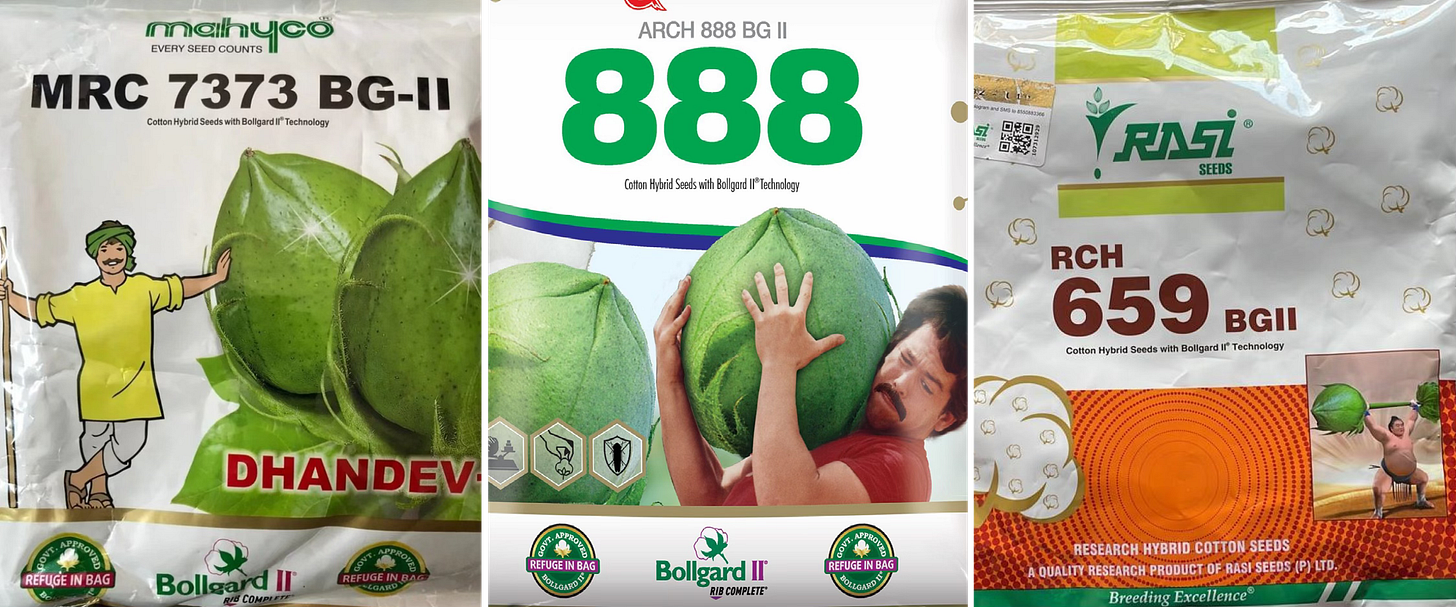
Step 2: The Baseline Fertiliser
Next came Bharat DAP,a synthetic fertiliser to be applied at sowing.
“25 kilograms is recommended by the government,” says the shopkeeper, “but I suggest 50 kilograms at ₹1350 per bag. It’s "on discount”, heavily subsidized by the government.
A bigger bag. A bigger hope.
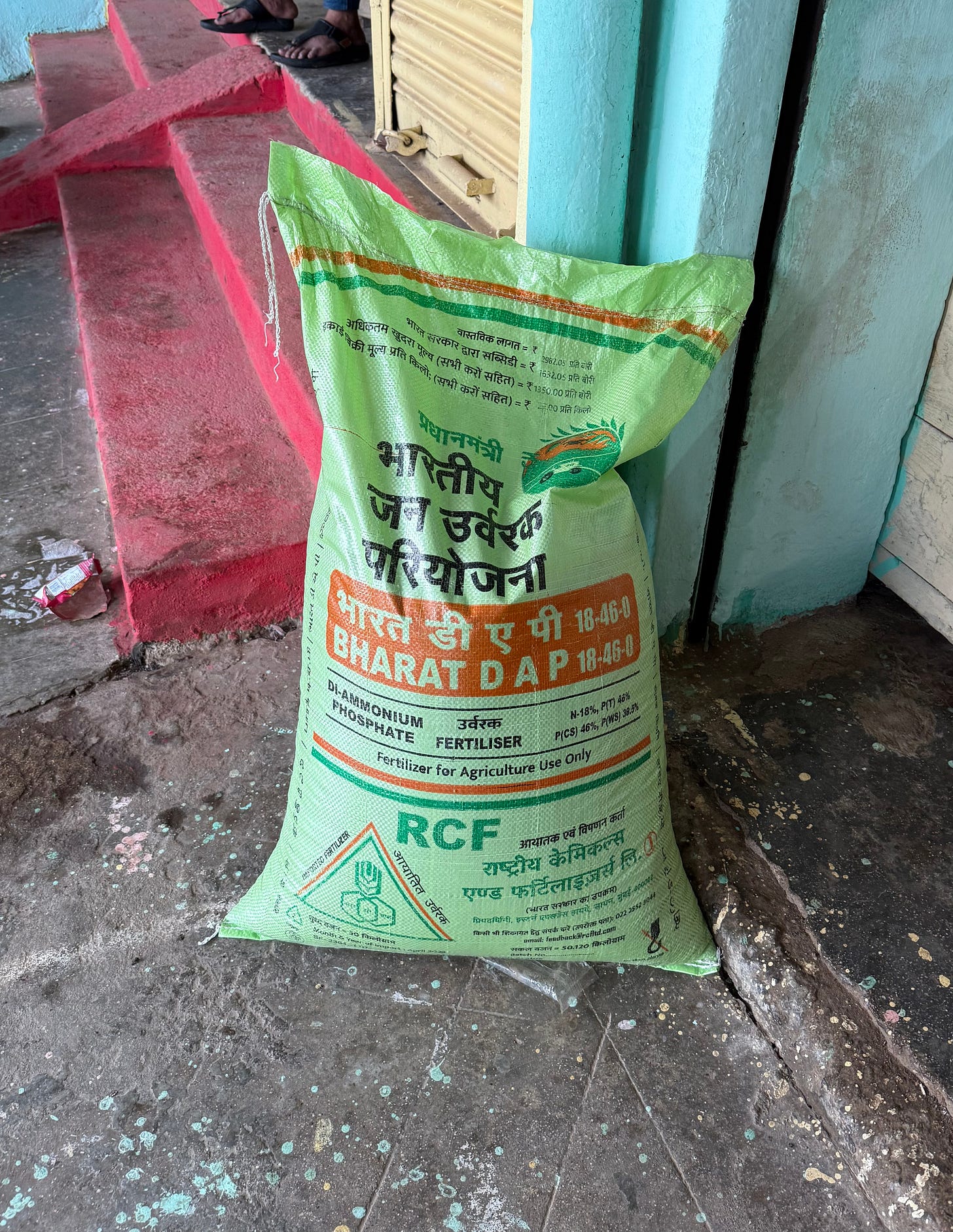
Step 3: Two Weeks Later — Boost the Germination
After about two weeks, once the seeds had germinated, I was instructed to apply neem-coated Urea, another government-subsidized fertiliser, delivering 46% nitrogen. 45 kilograms per acre, ₹266 per bag.
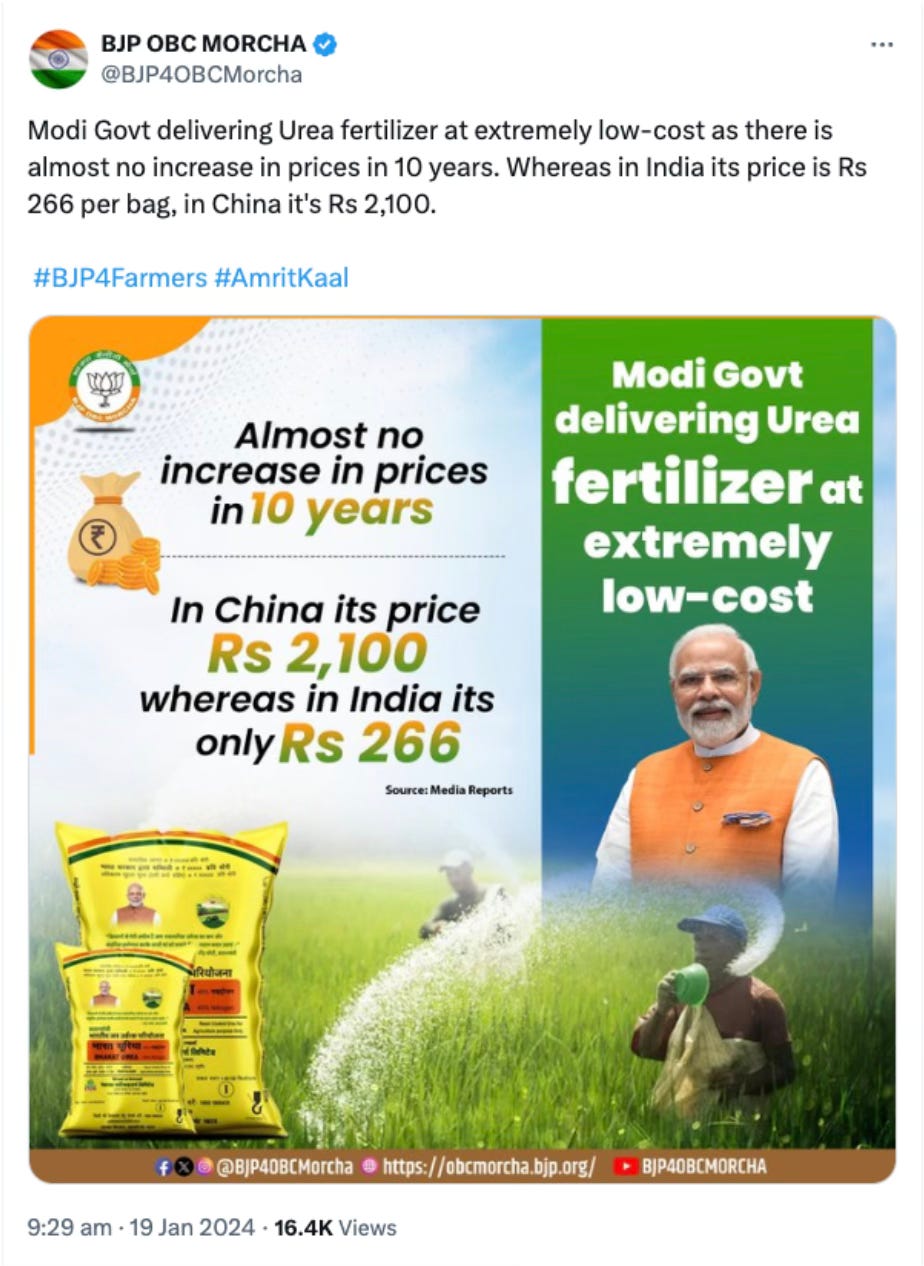
Step 4: One Month Later — The Strengtheners
At around 25–30 days, the shopkeeper gave me several options:
NPKS (branded Gromor), a balanced fertiliser with nitrogen, phosphorus, potassium, and sulphur, ₹1250 per bag for one acre.
Sulphur only (price unknown), to correct sulphur deficiencies common in cotton soils.
Potassium only, ₹1700 per bag, recommended if soils tested low in potassium.
Application would depend on my soil type and clay content. But typically, 2–3 applications per season.
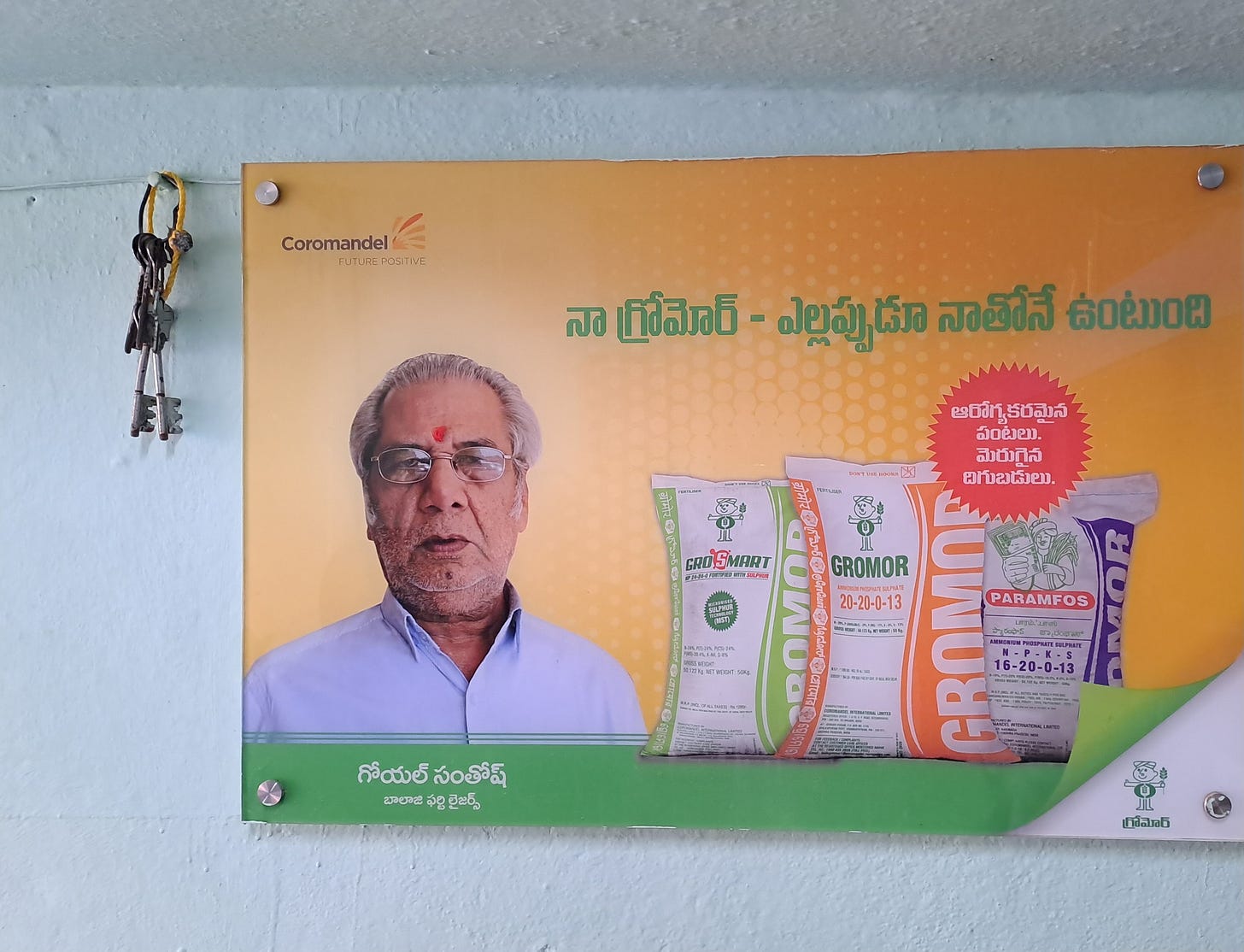
Step 5: Weed Management — The Optional, Expensive Shortcut
Next came herbicides: Hitweed MAXX,₹3200 per litre, diluted in 200 litres of water. Highly recommended if labour was scarce, the shopkeeper said.
Arun added some context for us: "There is a catch, this is very good with monocropping… the moment you have intercrops, it does not distinguish between them.”
Essentially, the herbicide would kill anything other than cotton.
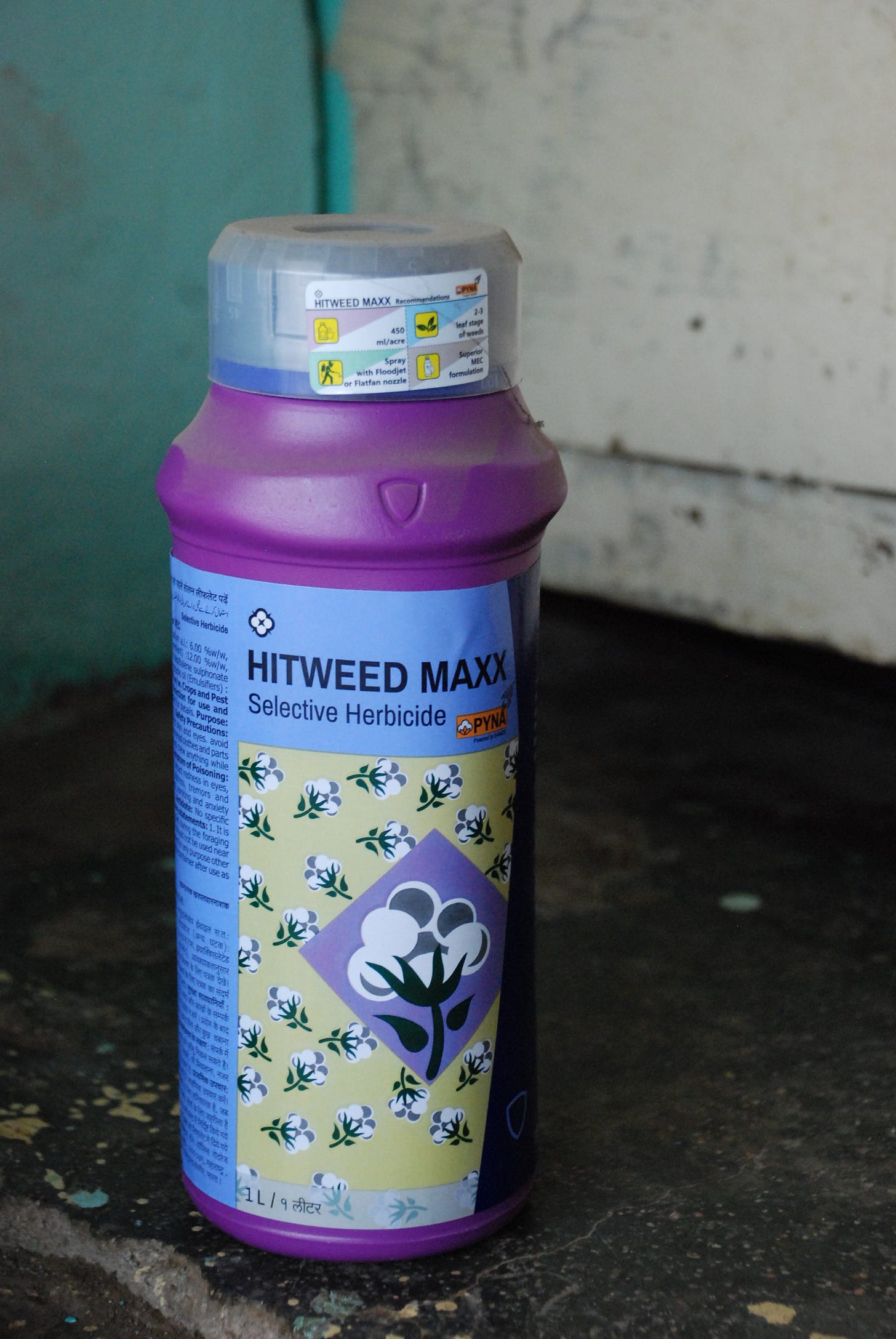
Step 6: Pest Control – Killing All the Insects
When I asked, "I have insects on my cotton, but I don’t know if they’re good or bad. What should I use?", Kaushik answered without hesitation:
"Insects are always bad." Everyone nodded.
And that’s when the brightest bottles started appearing. Pesticides Offered:
Monocrotophos – sold under names like Monocil and Monostar. One of the world’s most toxic organophosphate pesticides. Banned in India just weeks earlier, after decades of documented harm and a long legacy tied to farmer poisonings and suicides.
Confidor (Bayer) – a neonicotinoid pesticide, long banned in the EU, restricted in the US due to its devastating impact on pollinators like bees. It remains widely available in India.
“These will work for aphids, whiteflies. Also viruses,” the shopkeeper said. “₹700 per litre. ₹1400 for the stronger one.”
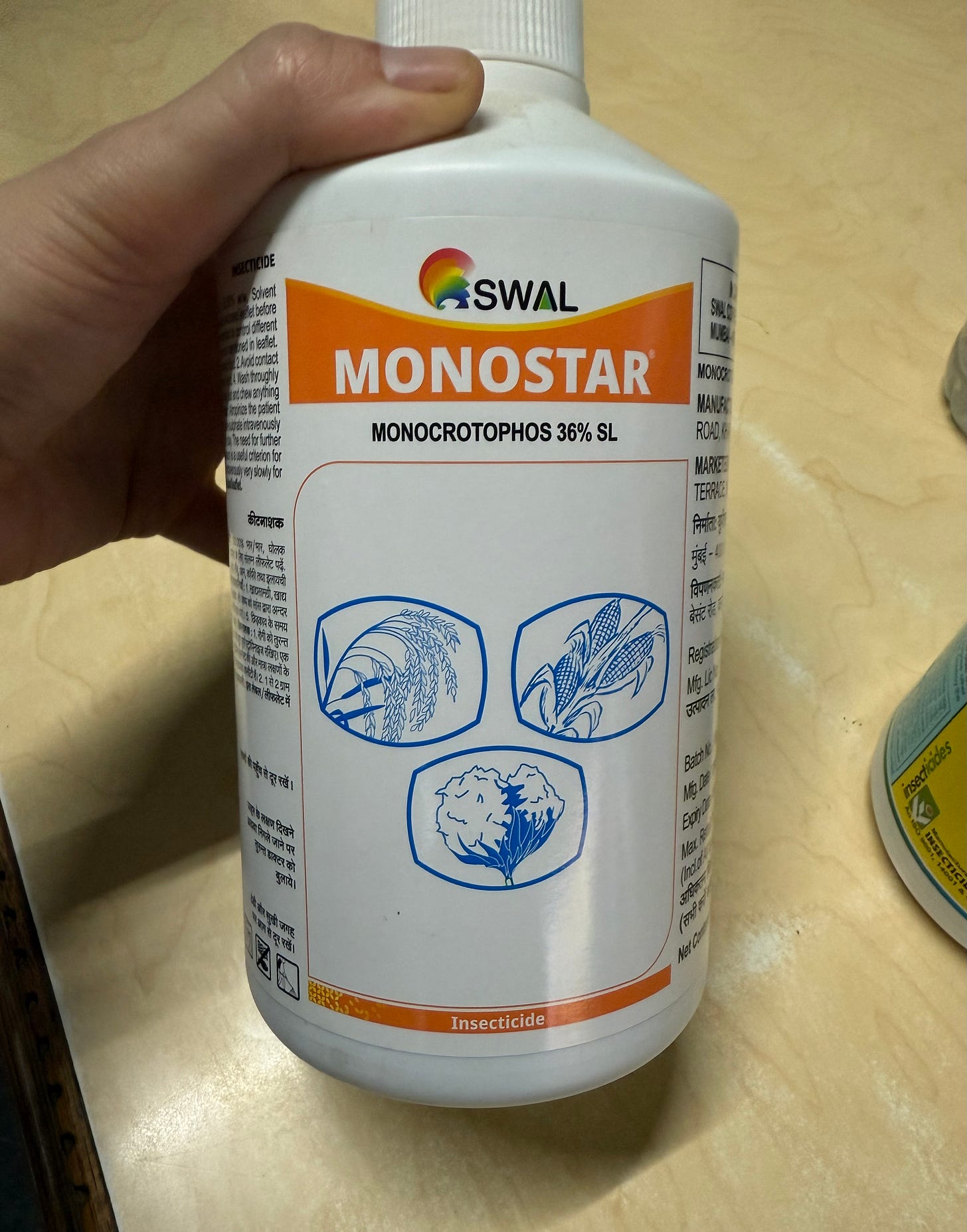
Protective gear?
"It’s available," he said, shrugging. Somewhere.
These chemicals aren’t obscure, they are the norm. Part of a global agricultural system where safer alternatives are underfunded, farmer training is patchy, and marketing often fills the gap.
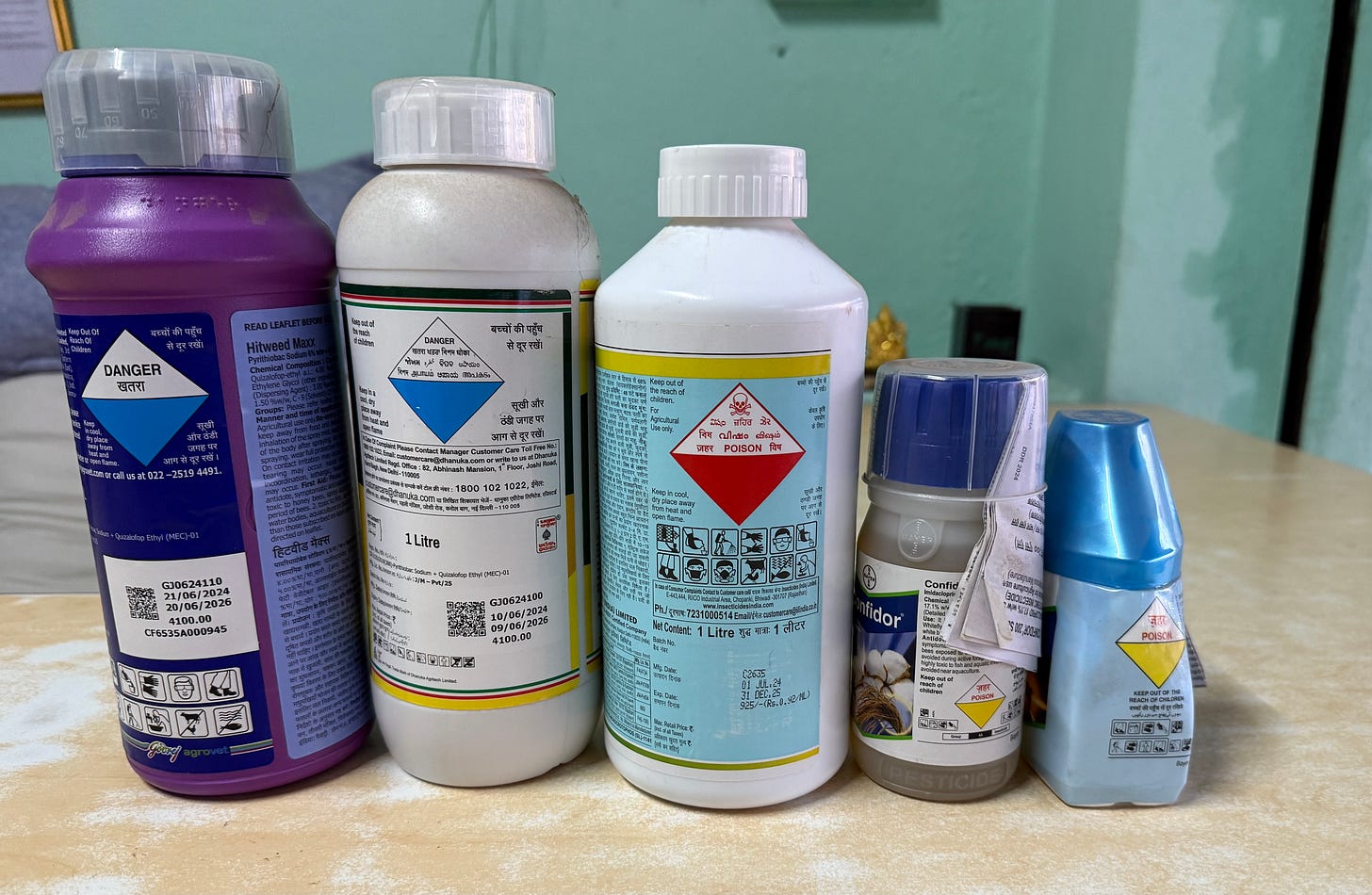
Total Package Cost and Something Else.
The full seasonal package (seeds, fertilisers, pesticides) would cost ₹11,000 to ₹15,000 (around €125–170). If you didn’t have the cash, you could pay 50% upfront, and borrow the rest — at 2% interest per month. No paperwork, no signatures. Just trust.
Because if an emergency comes (a funeral, a hospital bill, a school fee), this is where you’d turn for a loan.
And you would pay them back. You had to.
Because next season, you would need them again.
As Anne reflected later: “This is where trust lives in the system.”
Where Trust Becomes a Brand
We like to imagine that farmers make purely rational choices. That given a better, safer, more sustainable option, they’ll simply switch.
But that’s not how it works – not when the same shop that sells you fertiliser is also your emergency credit line. When sound agronomic advice is rare and marketing fills the void, when the bottle with a god, goddess, or a film star feels like your best chance, what choice do you really have?
Later our host, Arun, a veteran in cotton sustainability and our Cotton Diaries friend, explained: “Cotton farmers are especially brand-centric. They often choose pesticides with powerful names. Gods, actresses or big pictures of cotton bolls on the colourful plastic packets. Something that signals strength. Especially when literacy is low, packaging speaks louder than labels. Even bio-products for organic sell better in colourful bottles. It’s about familiarity, it’s India.”
In systems like this, branding becomes instruction. Packaging becomes a decision. Trust becomes a logo.
(Fashion folks, sound familiar?)
From Inputs to Gins
Later that evening, Sanjeev wanted to show us the next step: the cotton gin.
The gin sits in Indervelli - a protected area reserved for tribal communities, the Gonds and Lambadas, since the 70s. Sanjeev’s family set it up just before the reservation law took effect, and it’s been running for over 50 years.
When we visited, it was operating under India’s Minimum Support Price (MSP) scheme, where the Cotton Corporation of India (CCI) leases gins like Sanjeev’s and pays ₹1,250 per bale (about $15 USD) in processing fees. Of that, Sanjeev told us, around ₹950 covers running costs, leaving a slim but steady margin.
It’s not glamorous work. Each bale takes six people to lift, from gin to the truck. The workers, mostly seasonal migrants, split ₹15 (roughly $0.20 USD) earnings per bale between them.
The work is heavy. The pay is far lighter.
Season after season, the gin keeps going, weaving together regional livelihoods, state policy, and family legacy, all from a remote corner that few outside the system ever see.

That night, we had dinner at Kaushik’s elegant home. French wine options on the table, Tollywood-style wedding photos on the walls, and stories of fancy holidays to Paris and Spain.
His wife, Rashi, runs a company selling premium “sustainable” swimwear and resortwear using polyester blends. Global, trend-aligned, and far from the organic cotton fields we’d spent the day in. She mentioned that Zara is cheap for them.
It wasn’t lost on us. The shift in setting, the language around sustainability, the contrast between morning and evening. It all hung in the air.
Earlier that day, we’d spoken to farmers living on the edge of poverty, and watched migrant workers at the gin lifting bales for a fraction of what a single swimsuit or a Zara t-shirt might cost. That evening, we were in a different world, closer to the one back home – one where sustainability often speaks the language of status and aspiration, not subsistence.
These kinds of dissonances live everywhere in fashion: regenerative collections alongside overproduction, dashboards that trace cotton but not labour rights. Some contradictions we're used to. Others stay with you.
In a world where Sanjeev’s family's relative wealth could easily become a symbol of dissonance, it’s worth asking: who profits most?
Not the farmers.
Not even the ginners.
Probably not (or no longer) the local traders.
It’s the chemical giants (Bayer, Syngenta, and others) who perfected the art of selling promises, even when the soil told a different story.
It’s also the fashion brands, mostly based in the EU & US, countries where hazardous pesticides are banned, but there is profit to be made from the use of these chemicals elsewhere.
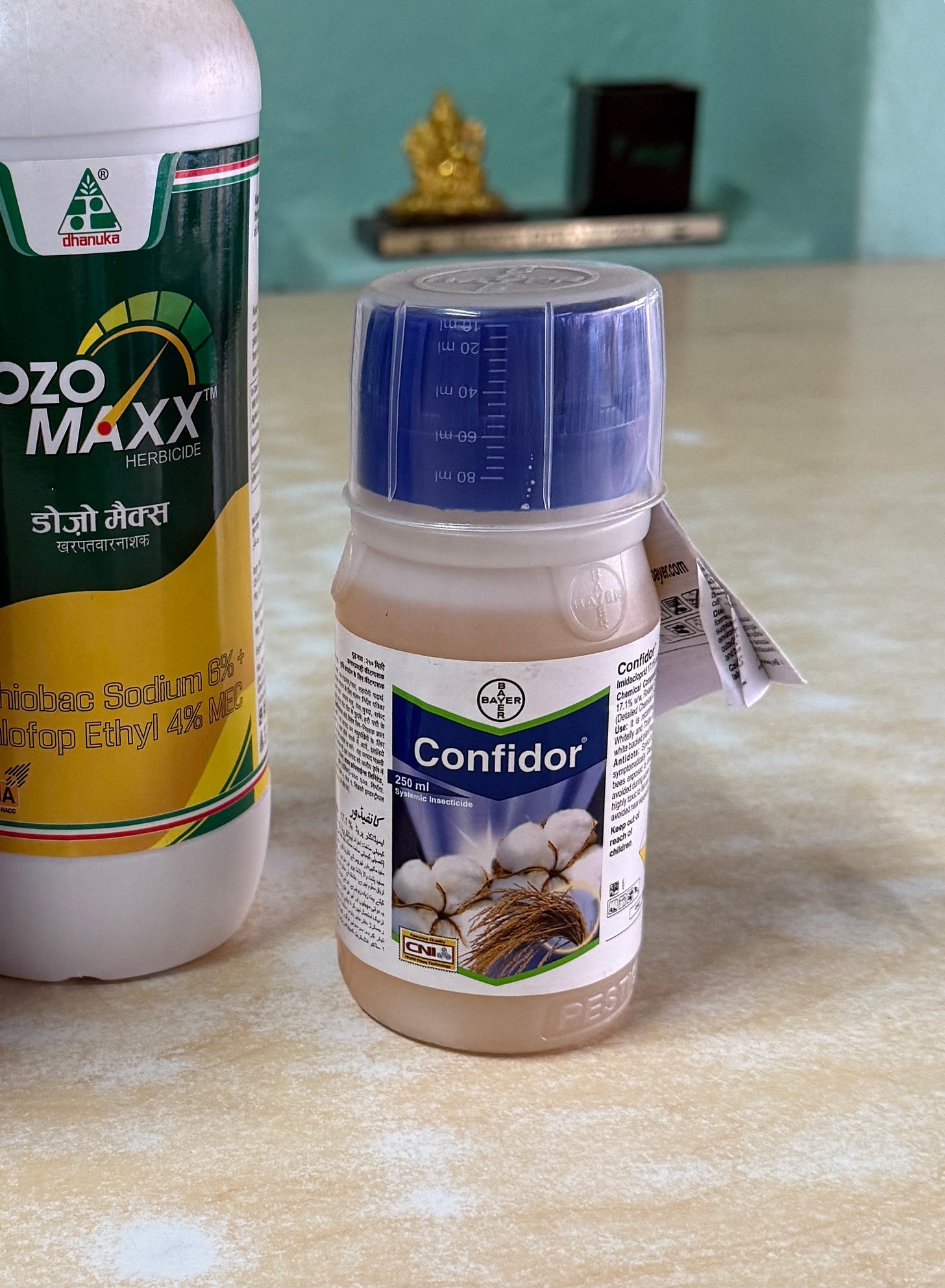
Brazilian geographer Larissa Bombardi uses the term “chemical colonialism” to describe the global double standard where hazardous pesticides banned in the Global North continue to be exported and sold across the Global South [or the World’s Majority].
What we witnessed in Telangana fits the pattern.
This isn’t about individual, informed choices. It’s about systems that push risk downward – onto those least protected, least resourced, least seen.
Fashion sits downstream from this.
When you buy cotton, you buy into the system that made it possible.
Who has cognitive dissonance now?
What Starting at the Source Really Looks Like
After a couple of days that passed both in a blur and in slow motion, crossing lives, landscapes, and stories, we were kindly driven back to Hyderabad by Sandeep and Sanjeev.
This car ride back felt like the consolidation of a mutual understanding. Sanjeev couldn’t reconcile the fact that the chemicals sold in his father's old shop, now run by local relatives, were the same ones spreading harm across his farmlands. The government allowed it. The system enabled it. And he was part of it, whether he liked it or not.
He seemed to lean more toward the emotional truth: why organic cotton, despite its risks, made deeper sense here.
We are yet to know the long-term effects of this visit, on us, on Sanjeev, on Kaushik, even on Sandeep, our quiet and steady driver coming from a “conventional” farming family. Some seeds sprout early. Others take years. Some may never emerge at all.
We like to believe we approached this visit with open curiosity, deep empathy, and humility, and were met with the same in return. And that, wherever it leads, is something worthwhile.
There’s a lot of talk in fashion about “starting at the source.” This is what it actually looks like:
Where chemicals banned in one country are business as usual in another.
Where loans and pesticides come from the same counter.
Where farmers know what they’re buying, and know they have little choice.
Where local trust holds more power than external fashionable promises.
This isn’t a story of ignorance. It’s a story of what’s available. What’s affordable. What’s normalised.
I often get asked: where should we start fixing cotton?
With ginners? Traders? Certifications? Chemical companies? Maybe. But maybe we also need to start here: in the relationships a local input shop has woven, where insects are always bad, and trust comes bottled and brightly coloured.
But maybe we also need to ask: why are these relationships the norm?
Why is farm management designed in faraway boardrooms… by corporations that direct the labs, fund the scientists, and sell the solutions? Why are input decisions dictated by marketing, not by farmers' lived experience or land-based and indigenous knowledge? Who gets to define what’s needed, what’s safe, what’s profitable, and for whom?
Where what’s rational is what’s relational.
Where what works (or seems to) holds until it doesn't.
Pulling the thread
This isn’t about blame.
It’s about clarity.
It’s about seeing the full picture: the contradictions, the dependencies, the power design.
It’s about asking:
What systems are we part of? And what systems do we want to build instead?
Let’s keep pulling the thread. Until what’s invisible becomes undeniable.
Author’s note:
Last December, I travelled to India with my collaborator Anne. Not just to drop in, but to stay, listen, and witness the layered realities behind cotton. This piece reflects what we saw, heard and experienced there. Our intention is not to single out individuals, but to illuminate the systemic realities many farmers and cotton actors navigate daily, and the choices shaped more by constraint than by preference.
All input prices, product names, and practices reflect what was observed and shared with us during field visits in Telangana in December 2024. Some names and identifying details have been omitted for privacy.
We thank our kind hosts, Arun, Sanjeev and his family, and patient drivers, Sandeep and Mehmood.
Marzia Lanfranchi is co-founder of Cotton Diaries and a sustainability consultant operating at the intersection of fashion and agriculture, specializing in cotton. Her unique perspective stems from a dual educational background in fashion and textiles design, as well as organic agriculture and agroecology.


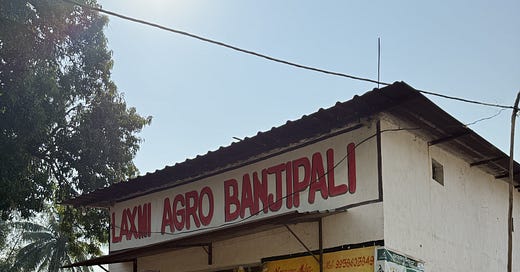



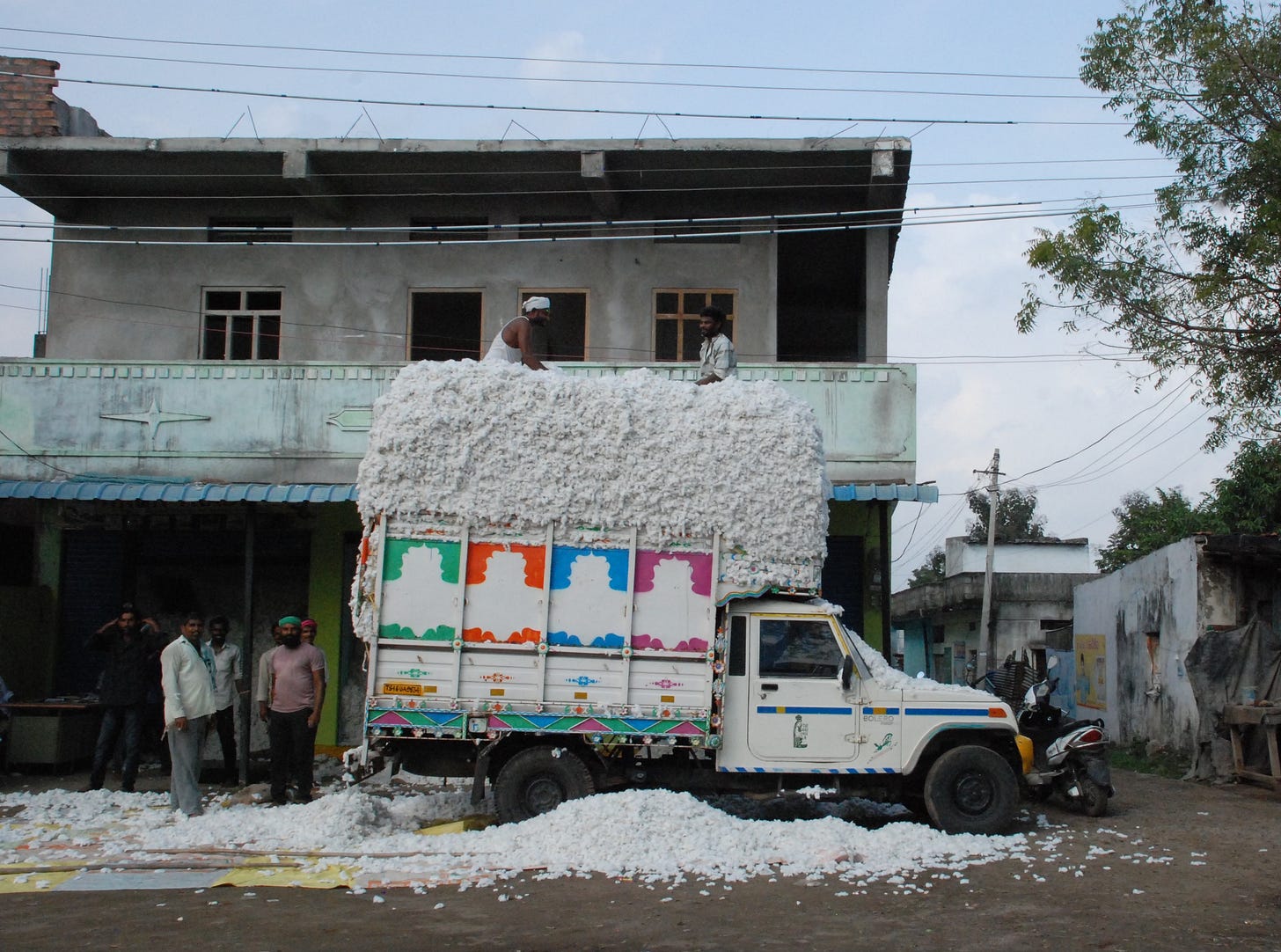
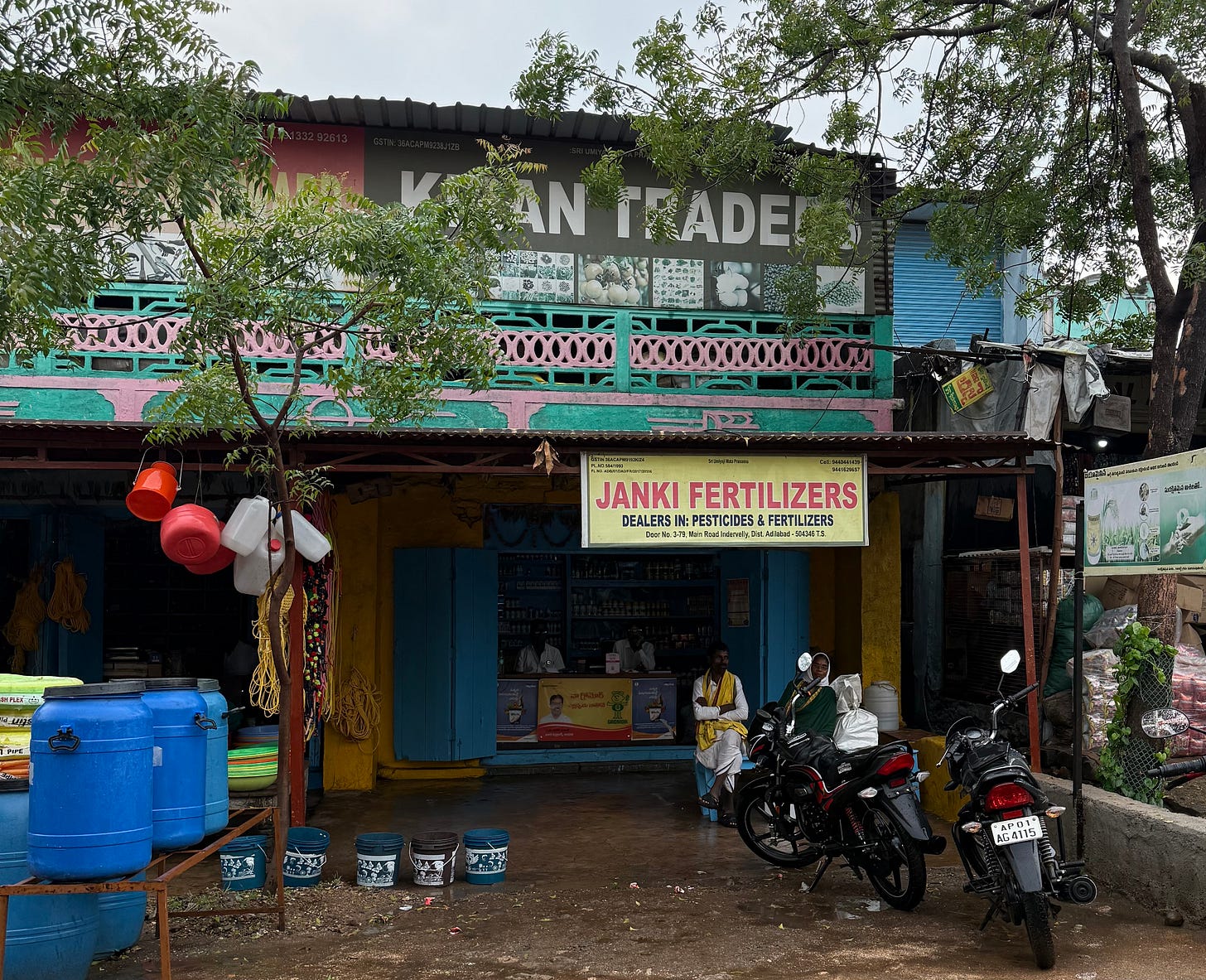
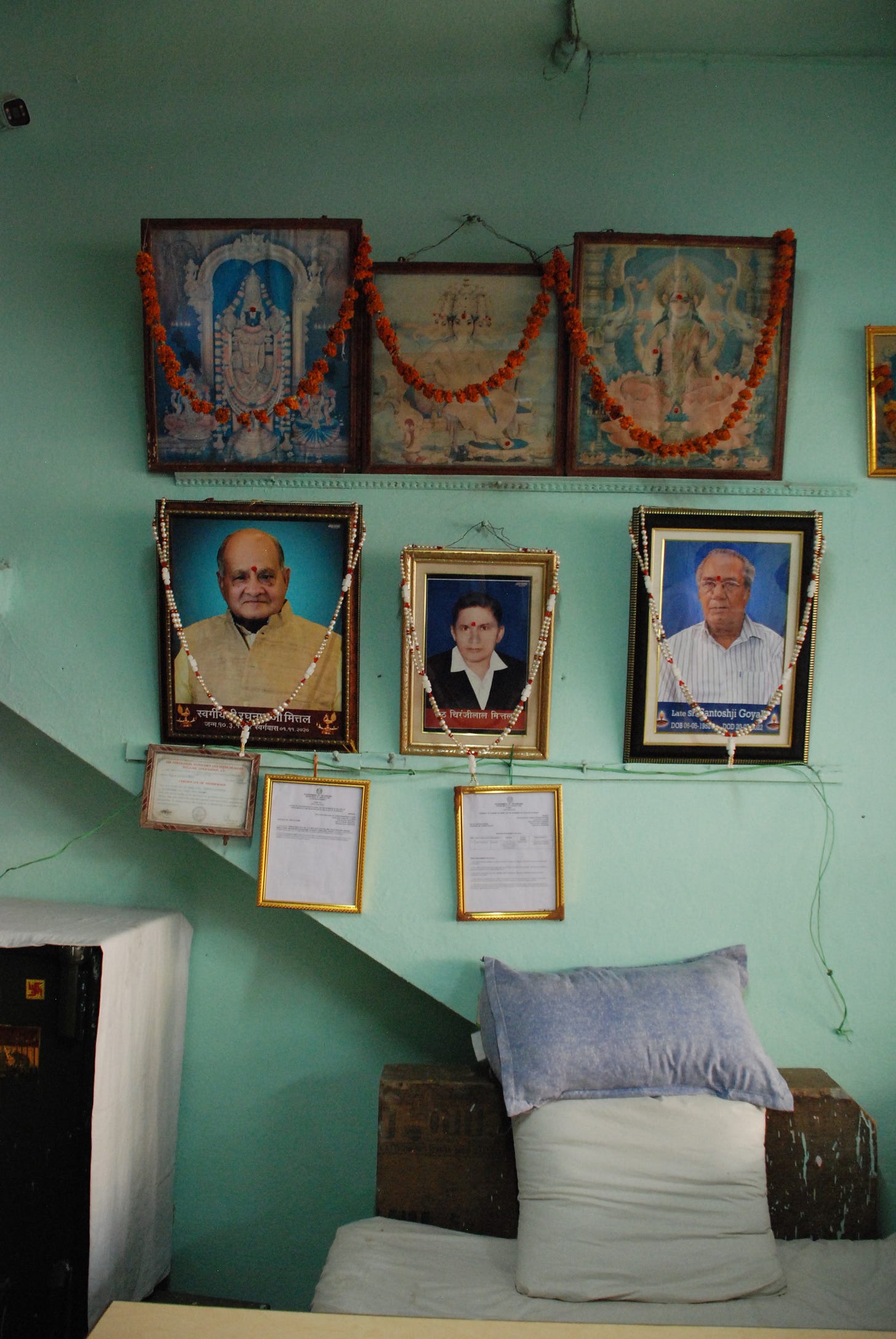
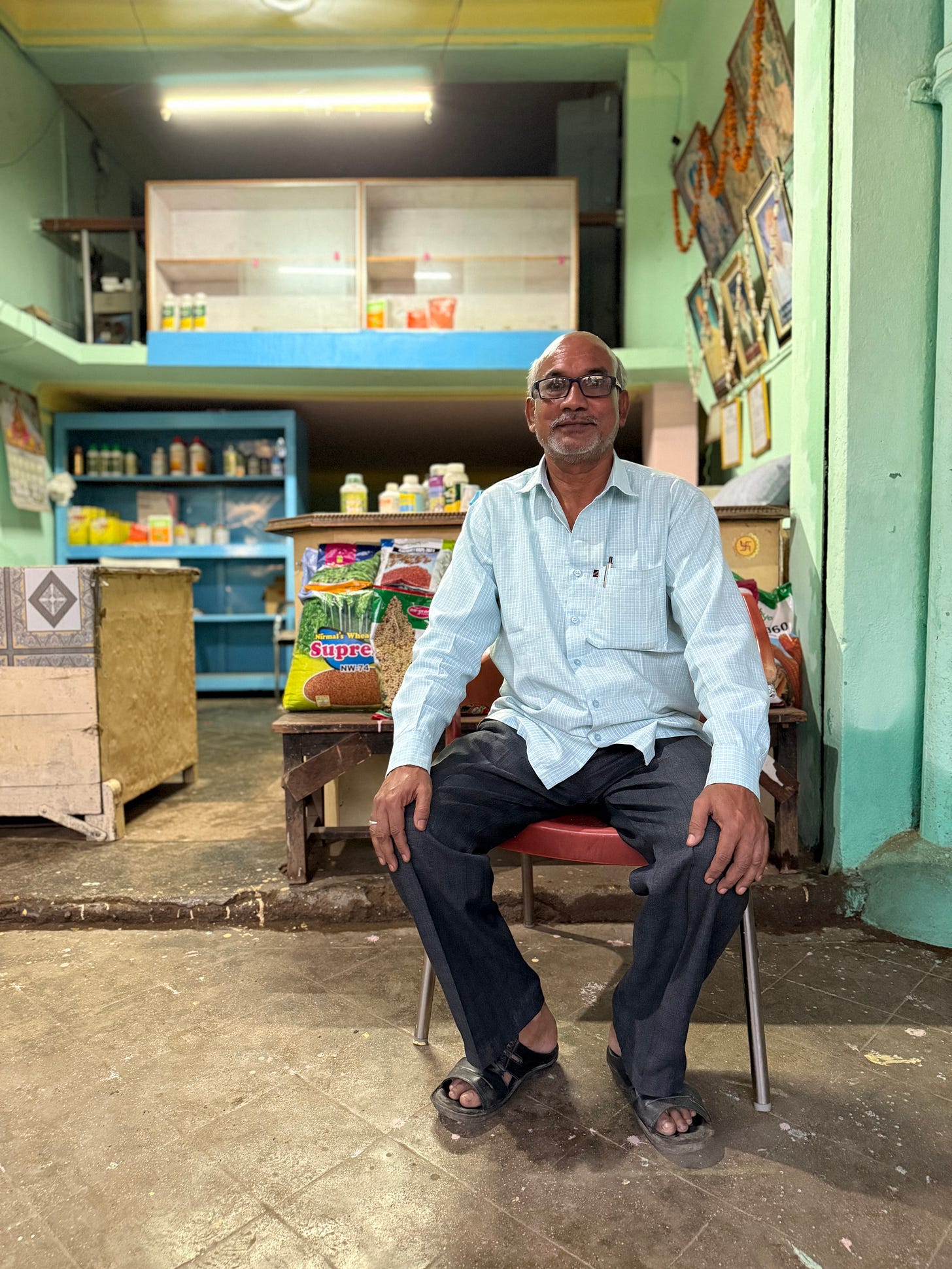

Lovely essay, Marzia. Lucidly written.
Take a step back and ask: why is the cotton acreage growing in India? Because it is the only crop that comes with assurance for a marketable surplus in dryland areas.
The broad answer is rooted in our vexed structural issues: dryland farming, low surpluses in grain agriculture, systemic exclusion in other crops, huge inflation, uncertainties of markets, stagnant off farm employment, lack of allied sector, rising wage labour costs, systemic push for the chemical systems...the list goes on and on.
What are challenges in making a switch to sustainable modes: no clarity or standardised procedures on what sustainable or regenerative agriculture means, zero systemic support - from lending to markets - and no policy support for the transition. There are in India nearly two dozen names for sustainable farming, and farmers making the switch are not sure if the marketable surplus will fetch a premium price or if the markets will differentiate between their produce that has not used chemicals and the produce grown by using chemicals.
So this transition is an arduous work in progress.
In the 1990s, post liberalisation, most state govts eased the earlier norms to give licenses to open an inputs shop. Today you don't require any degree or diploma in agriculture to open such a shop, just some capital to get going. Things began to snowball from there. Most of these dealers are also creditors to farmers and they get their supplies on long term credit from the companies. Input shops are now a big part of the rural political economy in India.
Marzia
I loved your post. So visual and impactful. I have walked cotton fields with local agronomists in Telangana for 2 years and seen the impact of excess N fertilizer you comment on.
Thank you for sharing this story.
Kater